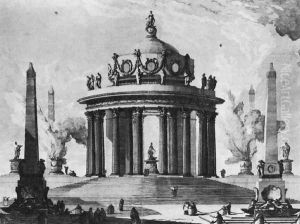Louis - Joseph Le Lorrain Paintings
Louis-Joseph Le Lorrain was a prominent French painter, draftsman, and designer, born in 1715 in Metz, France. His early life was marked by a move to Paris, where he entered the prestigious Académie Royale de Peinture et de Sculpture. Le Lorrain's talent was recognized early on, and he became a student of the esteemed painter François Boucher, whose influence is evident in Le Lorrain's delicate and refined style. His work, however, also developed a distinct character, blending Rococo elegance with a sense of classical restraint.
In 1738, at the age of 23, Le Lorrain won the coveted Prix de Rome, a scholarship for art students to study in Rome at the expense of the French crown. His time in Italy was transformative; he was deeply influenced by the ancient and Renaissance art he studied there. During his stay, Le Lorrain produced a variety of works, including landscapes, historical scenes, and studies of antiquities, which demonstrated his growing interest in classical subjects and his departure from the purely decorative Rococo style.
After returning to France, Le Lorrain's reputation continued to grow. He was admitted as a member of the Académie Royale in 1745, and his works were sought after by the French aristocracy and royalty. Despite his success, Le Lorrain's career was relatively short-lived; he moved to Saint Petersburg, Russia, in 1758 at the invitation of the Empress Elizabeth to become the first director of the Imperial Academy of Arts. His mission was to elevate the status of Russian art and to oversee the education of young Russian artists in the European tradition. Unfortunately, Le Lorrain's time in Russia was brief; he died in Saint Petersburg in 1759, just a year after his arrival.
Throughout his career, Louis-Joseph Le Lorrain was celebrated for his ability to infuse classical subjects with a modern sensibility, contributing significantly to the transition from Rococo to Neoclassicism. His legacy is evident in the works of the students he taught and influenced, both in France and Russia. Despite his premature death, Le Lorrain's art remains a testament to his remarkable talent and his pivotal role in the evolution of 18th-century European art.
